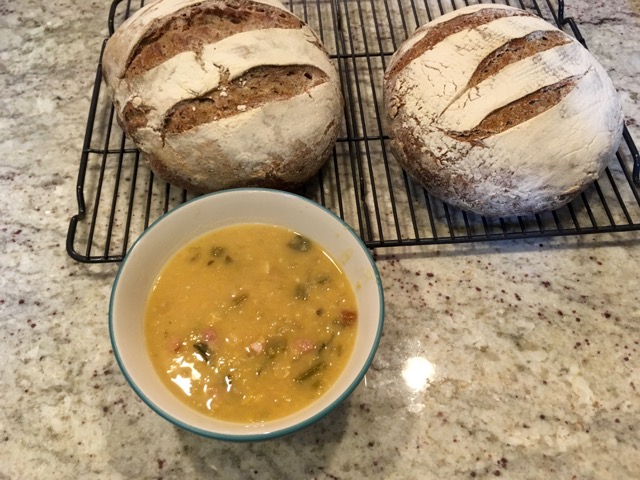There are unphotogenic foods, and there are unphotogenic foods. It’s tough to make a mushy bowl of legumes look appetizing, no matter how delicious it might be off the screen; it’s even tougher when after being cooked, said lentils form an amorphous mass that’s just about the exact color and texture of fresh vomit. And I’m a parent now, so trust me when I say that I know a thing or two about vomit.
Still, let it be known: there’s something undeniably comforting about split pea soup with ham, even to this avowed Jew. I have no fuzzy childhood memories of slurping down a bowl of this rib-sticking soup on a blustery fall day; I only ate the stuff for the first time when I made it myself. When I did, though, I was pleasantly surprised to learn that the soup was a lot tastier than it was beautiful—warm and toothsome and pleasingly salty, the kind of dish a food magazine might describe as an “umami bomb.” (Personally, I don’t believe “umami” is a real flavor; I will not be accepting questions at this time.)
All of this came as a bit of a shock to me, largely because I still have no idea what this recipe is doing in my grandmother’s cookbook. She didn’t keep kosher—at least, not since the Bacon Incident—but she also didn’t really make a habit of serving pig, at least not when my mother and uncles were growing up. She spent most of her life in southern California, which isn’t exactly soup country.
Maybe she had a secret passion for this particular yellow slop; maybe it was just so quintessentially American she couldn’t resist including it in her collection of midcentury favorites. In any case, I wound up being glad she did.
Ham and Split Pea Soup
1 ham bone or 1.5 cup chopped ham [A cup, of course, is a measure of volume, not one of weight. This means that if your butcher won’t sell you a ham bone, you’re in for a very confusing conversation about how much ham, precisely, you need for this recipe. I thought it’d wind up being around half a pound, but the butcher convinced me I needed more, so I bought more. For the record, I was right]
2 cups dried split peas [Nonnie probably intended us to use the green variety, but I had yellow ones in my cupboard, so I used them instead. As I understand from cursory internet research, the yellow ones are a little starchier and milder-tasting, while the green ones are sweeter—so maybe the soup’s even better if you use the right kind of beans]
2 teaspoons salt [Which might seem like a lot of salt, especially since ham is already salty—but trust the recipe here. Like potatoes, split peas seem to be salt sponges, necessitating way more seasoning than one might expect]
1 onion, sliced
1/4 teaspoon white pepper
6 cups water
[Evidently, Nonnie didn’t think her original version of this recipe was flavorful enough, so she wrote in the following three ingredients longhand as well:]
1 stalk celery
2 cloves garlic
1 teaspoon Worcestershire sauce
Combine all ingredients in a large pot. Bring to a boil, mix well; cover, and simmer over low heat 2.5 to 3 hours. Garnish with croutons.
[Oof, so: I could have followed the instructions precisely here. But it hurt my soul to simply toss a bunch of stuff in a pot, knowing that a) I was going to be eating this soup all week, and b) it would taste a lot better if I sautéed the vegetables in some oil first, then added the meat, then put in the water. So that’s what I did. It’s technically a deviation from the recipe, which goes against the rules I set for myself back when I started this blog—but one I hope Nonnie would have approved of in the name of flavor.]
The verdict: Ugly? Oh, it’s ugly. Tasty? Oh, it’s tasty.
The peas had broken down almost entirely at two hours, and I didn’t notice much of a difference after two and a half hours had elapsed—so I see no need to leave this soup on the stove for a full three hours. (Of course, it’d go exponentially faster if you made the recipe using an Instant Pot, a piece of shortcut kitchen technology Nonnie could only have dreamed of.)
But other than that questionable instruction—and the fact that it needed even more salt than the recipe called for—this soup is pretty solid as written, which often isn’t the case with Nonnie’s savory recipes. I like that it’s a hearty, one-pot recipe that doesn’t require a cook to have broth on hand (though I’m not sure many people have a stash of ham bones in their fridge at any given time); I also like the way the meat plays a supporting role in the finished product, rather than taking center stage. And I certainly can’t argue with anything that goes this nicely with a big loaf of freshly-baked sourdough.
Am I using this as an opportunity to brag about my pretty, pretty bread—which has nothing to do with Nonnie’s cookbook? You bet your split peas I am.




